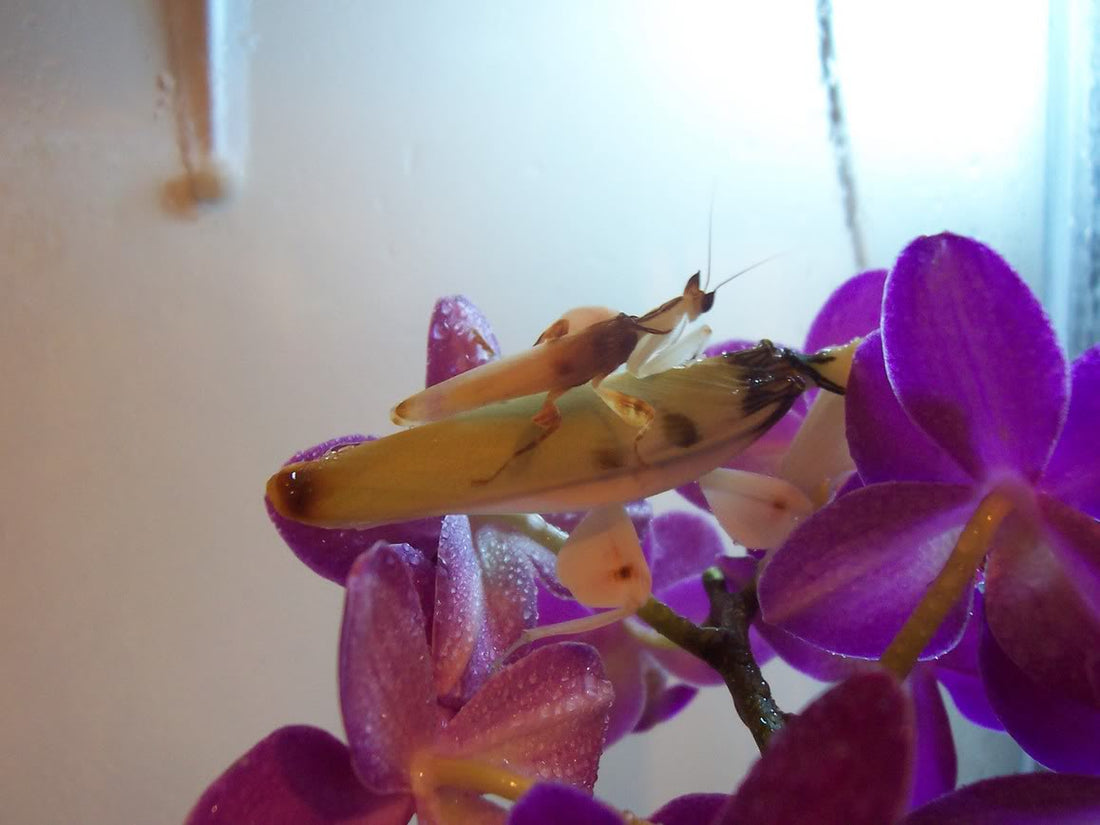The Orchid Mantis, Hymenopus coronatus, stands out as a jewel among praying mantises, admired for its exquisite beauty and intriguing behaviour. This guide delves deep into the care, breeding, and maintenance of this captivating species, offering enthusiasts a comprehensive overview.
Classification and Description
- Order: Mantodea
- Family: Hymenopodidae
- Subfamily: Hymenopodinae
- Genus: Hymenopus
- Species: coronatus
Origin
Hymenopus coronatus originates from diverse Asian locales, including Borneo, southern China, Java, Malaysia, Sumatra, and Thailand. This wide distribution contributes to its adaptability in captivity, provided that its environmental needs are met.
Appearance
- General Coloration: Predominantly white with varying shades of pink, occasionally displaying yellow hues. The species exhibits sexual dimorphism, with females sporting a green collar around the thorax and males a brown one.
- Wings: Females have hyaline to yellow wings, while males feature purely hyaline wings.
- Size: Males measure 2-3 cm, whereas females are significantly larger, ranging from 5-7 cm.
Lifecycle and Growth Dynamics
Understanding the growth and lifecycle of Hymenopus coronatus is crucial for successful care and breeding.
- Growth Period: Ranges from 2 to 5 months, influenced by sex and environmental conditions. The notable size disparity between sexes poses a challenge for synchronized maturation and mating.
- Molting and Lifespan: Males undergo 5 molts, living 3-5 months post-final molt. Females experience 8 molts and have a lifespan of 5-10 months thereafter.
Care Requirements
Proper care is essential for the health and well-being of Hymenopus coronatus. Here are detailed care instructions:
Temperature and Humidity
- Daytime Temperature: 25-32°C
- Nighttime Temperature: 18-25°C
- Daytime Humidity: 50-60%
- Nighttime Humidity: 70-100%, with misting 4-7 times weekly, preferably in the evening.
Terrarium Setup
- Size: A minimum of 20x20x20 cm for an adult female; males can be housed in a 1-liter terrarium.
- Ventilation: A wide-spaced mesh top is crucial to prevent the mantis from getting stuck and to ensure adequate airflow.
- Group Housing: While females can show aggression, group housing is feasible, especially for males, which display no aggression towards each other as adults.
Substrate and Feeding
- Substrate: Coco peat or peat moss, kept moist, is ideal.
- Diet: A diet of 100% flying prey, such as Drosophila fruit flies for early stages and larger flies or moths for adults, mimics their natural feeding habits. Adult females may consume numerous flies weekly, supplemented with soft-chitined cockroaches for additional nutrition.
Breeding Insights
Breeding Hymenopus coronatus presents its own set of challenges, from managing the size disparity between sexes to ensuring successful egg incubation.
Sexual Maturity and Mating
- Males: Reach sexual maturity approximately 7-10 days post-final molt.
- Females: Take about 15-20 days to mature sexually.
- Mating Duration: Can last between 4 to 7 hours, with males often repeating the process.
Egg Laying and Incubation
- Oothecae Production: Females lay 2 to 7 oothecae, starting 15 days to a month after mating, with intervals of 15 to 30 days between each.
- Incubation Conditions: Require careful humidity control (60-90%) and a temperature range of 22-28°C.
- Hatching: Occurs 40-50 days later, producing 20 to 150 nymphs per ootheca.
Conclusion: The Beauty and Challenge of Keeping Hymenopus coronatus
The Orchid Mantis is not only a testament to nature's artistry but also a rewarding challenge for the dedicated enthusiast. While not recommended for beginners, especially those interested in breeding, the successful care and breeding of Hymenopus coronatus can be a fulfilling endeavor. Incorporating a real or artificial orchid into the terrarium not only enhances its beauty but also creates a more natural environment for these magnificent creatures. With patience, proper care, and attention to detail, enthusiasts can enjoy the unique experience of keeping one of the most beautiful mantis species in the world.

